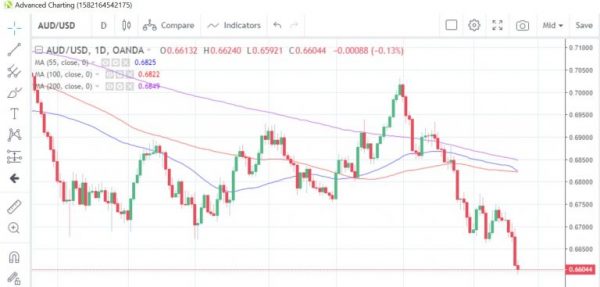The shift in risk appetite overnight, caused by a jump in new CoVid-19 cases outside of China, piled more pressure on the beleaguered Aussie. Weak local data added to the downforce, pressing AUD/USD to the lowest levels in 11 years.
Australia services PMI drops below 50
The Commonwealth Bank services PMI for February fell sharply to 48.4 from 50.6 last month. Expectations were for an improvement to 52.4 but instead the index fell to the lowest level since the index started in 2018. A combination of subdued client demand, adverse weather and the CoVid-19 outbreak contributed to the lower reading.
AUD/USD felt more pressure this morning, posting incremental losses on yesterday’s drop and reaching fresh 11-year lows. The FX pair is at 0.6604 and is poised for its fourth daily loss in a row, with the March 2009 low at 0.6285.
AUD/USD Daily Chart
Negative sentiment in Asia
The shift in sentiment that occurred overnight has continued into today’s morning session in Asia. US indices are down between 0.20% and 0.32%, with the NAS100 index under-performing. The two indices in positive territory are the China50 index, which is up 0.75% and the HongKong33 index which is up 0.21%.
A spike in the number of new cases reported in South Korea was behind the turnaround in sentiment, with 52 new cases reported. South Korea is now second in the league behind China for the total number of CoVid-19 cases. The global total stands at 76,497 at 11.30am Singapore time, with deaths at 2,247.
South Korean President Moon said an economic package including financial, tax and budget steps by the end of February. The Health Ministry has maintained its current alert status and has said it has no plans to expand its entry ban on visitors from China. Japanese press has reported that Tokyo has cancelled or postponed major indoor events for the next three weeks.
Flash PMIs on tap
Today we see the flash PMI readings from Markit for February for Europe and the US. According to the latest surveys, Germany’s index is expected to be the weakest, with a forecast of 44.8 from 45.3 last month. The Euro-zone’s index is seen dipping to 47.5 from 47.9, while that for the UK is expected to fall to 49.7 from 50.0.
The US flash PMI probably fell to 51.5 from 51.9, according to the surveys. US existing home sales for January are also due and seen falling 1.8% m/m after a 3.6% gain in December. The week concludes with speeches from Fed’s Brainard, Mester and Clarida.


 Signal2forex.com - Best Forex robots and signals
Signal2forex.com - Best Forex robots and signals




